Perovskite Solar Cell on Stainless Steel Substrate over 10% Efficiency for Building-Integrated Photovoltaics
Abstract
:1. Introduction
2. Materials and Methods
2.1. Preparation of Materials
2.2. Perovskite Solar Cell Fabrication
2.3. Measurement
3. Results and Discussion
3.1. Confirmation of SiO2 Film for Diffusion Barrier
3.2. Perovskite Solar Cells on SS Substrates
4. Conclusions
Author Contributions
Funding
Data Availability Statement
Conflicts of Interest
References
- Ostfeld, A.E.; Arias, A.C. Flexible photovoltaic power systems: Integration opportunities, challenges and advances. Flex. Print. Electron. 2017, 2, 013001. [Google Scholar] [CrossRef]
- Lacerda, J.S.; Van Den Bergh, J.C. Diversity in solar photovoltaic energy: Implications for innovation and policy. Renew. Sustain. Energy Rev. 2016, 54, 331–340. [Google Scholar] [CrossRef]
- Alaaeddin, M.; Sapuan, S.; Zuhri, M.; Zainudin, E.; Al-Oqla, F.M. Photovoltaic applications: Status and manufacturing prospects. Renew. Sustain. Energy Rev. 2019, 102, 318–332. [Google Scholar] [CrossRef]
- Meddeb, H.; Götz-Köhler, M.; Neugebohrn, N.; Banik, U.; Osterthun, N.; Sergeev, O.; Berends, D.; Lattyak, C.; Gehrke, K.; Vehse, M. Tunable photovoltaics: Adapting solar cell technologies to versatile applications. Adv. Energy Mater. 2022, 12, 2200713. [Google Scholar] [CrossRef]
- Biyik, E.; Araz, M.; Hepbasli, A.; Shahrestani, M.; Yao, R.; Shao, L.; Essah, E.; Oliveira, A.C.; Del Cano, T.; Rico, E. A key review of building integrated photovoltaic (BIPV) systems. Eng. Sci. Technol. Int. J. 2017, 20, 833–858. [Google Scholar] [CrossRef]
- Heinstein, P.; Ballif, C.; Perret-Aebi, L.-E. Building integrated photovoltaics (BIPV): Review, potentials, barriers and myths. Green 2013, 3, 125–156. [Google Scholar] [CrossRef]
- Kuhn, T.E.; Erban, C.; Heinrich, M.; Eisenlohr, J.; Ensslen, F.; Neuhaus, D.H. Review of technological design options for building integrated photovoltaics (BIPV). Energy Build. 2021, 231, 110381. [Google Scholar] [CrossRef]
- Yang, R.J.; Zou, P.X. Building integrated photovoltaics (BIPV): Costs, benefits, risks, barriers and improvement strategy. Int. J. Constr. Manag. 2016, 16, 39–53. [Google Scholar] [CrossRef]
- Duigou, T.; Boichon, V.; Brancaz, X.; Chabuel, F.; Francescato, P.; Gaume, J.; Habchi, G.; Lagache, M.; Saffré, P.; Tenchine, L. VIPV: Process development of integrated photovoltaic cells in a double-curved composite structure for automotive application. In Proceedings of the 37th European Photovoltaic Solar Energy Conference and Exhibition, Online, 7–11 September 2020; pp. 7–12. [Google Scholar]
- Araki, K.; Ota, Y.; Lee, K.-H.; Yamada, N.; Yamaguchi, M. Curve correction of the energy yield by flexible photovoltaics for VIPV and BIPV applications using a simple correction factor. In Proceedings of the 2019 IEEE 46th Photovoltaic Specialists Conference (PVSC), Chicago, IL, USA, 16–21 June 2019; 2019; pp. 1584–1591. [Google Scholar]
- Commault, B.; Duigou, T.; Maneval, V.; Gaume, J.; Chabuel, F.; Voroshazi, E. Overview and perspectives for vehicle-integrated photovoltaics. Appl. Sci. 2021, 11, 11598. [Google Scholar] [CrossRef]
- Samadi, H.; Ala, G.; Lo Brano, V.; Romano, P.; Viola, F. Investigation of Effective Factors on Vehicles Integrated Photovoltaic (VIPV) Performance: A Review. World Electr. Veh. J. 2023, 14, 154. [Google Scholar] [CrossRef]
- Green, M.A.; Ho-Baillie, A.; Snaith, H.J. The emergence of perovskite solar cells. Nat. Photonics 2014, 8, 506–514. [Google Scholar] [CrossRef]
- Correa-Baena, J.-P.; Saliba, M.; Buonassisi, T.; Grätzel, M.; Abate, A.; Tress, W.; Hagfeldt, A. Promises and challenges of perovskite solar cells. Science 2017, 358, 739–744. [Google Scholar] [CrossRef] [PubMed]
- Jung, H.S.; Park, N.G. Perovskite solar cells: From materials to devices. Small 2015, 11, 10–25. [Google Scholar] [CrossRef] [PubMed]
- Kang, D.-W.; Ryu, J.; Konagai, M. High-performance amorphous silicon thin film solar cells prepared at 100 C: Toward flexible building-integrated photovoltaics. Electron. Mater. Lett. 2019, 15, 623–629. [Google Scholar] [CrossRef]
- Kim, S.; Hoang, V.Q.; Bark, C.W. Silicon-based technologies for flexible photovoltaic (Pv) devices: From basic mechanism to manufacturing technologies. Nanomaterials 2021, 11, 2944. [Google Scholar] [CrossRef] [PubMed]
- Kim, S.; Van Quy, H.; Bark, C.W. Photovoltaic technologies for flexible solar cells: Beyond silicon. Mater. Today Energy 2021, 19, 100583. [Google Scholar] [CrossRef]
- Ramanujam, J.; Bishop, D.M.; Todorov, T.K.; Gunawan, O.; Rath, J.; Nekovei, R.; Artegiani, E.; Romeo, A. Flexible CIGS, CdTe and a-Si: H based thin film solar cells: A review. Prog. Mater. Sci. 2020, 110, 100619. [Google Scholar] [CrossRef]
- Ahn, K.; Kim, S.-Y.; Kim, S.; Son, D.-H.; Kim, S.-H.; Kim, S.; Kim, J.; Sung, S.-J.; Kim, D.-H.; Kang, J.-K. Flexible high-efficiency CZTSSe solar cells on stainless steel substrates. J. Mater. Chem. A 2019, 7, 24891–24899. [Google Scholar] [CrossRef]
- Jung, K.H.; Yun, S.J.; Lee, S.H.; Lee, Y.J.; Lee, K.-S.; Lim, J.W.; Kim, K.-B.; Kim, M.; Schropp, R. Double-layered Ag–Al back reflector on stainless steel substrate for a-Si: H thin film solar cells. Sol. Energy Mater. Sol. Cells 2016, 145, 368–374. [Google Scholar] [CrossRef]
- Kranz, L.; Gretener, C.; Perrenoud, J.; Schmitt, R.; Pianezzi, F.; La Mattina, F.; Blösch, P.; Cheah, E.; Chirilă, A.; Fella, C.M. Doping of polycrystalline CdTe for high-efficiency solar cells on flexible metal foil. Nat. Commun. 2013, 4, 2306. [Google Scholar] [CrossRef]
- Kumar, V.; Wang, H. Selection of metal substrates for completely solution-processed inverted organic photovoltaic devices. Sol. Energy Mater. Sol. Cells 2013, 113, 179–185. [Google Scholar] [CrossRef]
- Pianezzi, F.; Chirilă, A.; Blösch, P.; Seyrling, S.; Buecheler, S.; Kranz, L.; Fella, C.; Tiwari, A. Electronic properties of Cu (In, Ga) Se2 solar cells on stainless steel foils without diffusion barrier. Prog. Photovolt. Res. Appl. 2012, 20, 253–259. [Google Scholar] [CrossRef]
- Zhou, Z.; Wang, Y.; Su, Y.; Yang, Z.; Zhang, Y. Carbon/F-doped SnO2 nanowires array counter electrode for dye sensitized solar cell. Optoelectron. Adv. Mater. Rapid Commun. 2010, 4, 1332–1335. [Google Scholar]
- National Renewable Energy Laboratory (NREL). Available online: https://www.nrel.gov/pv/assets/pdfs/best-research-cell-efficiencies.pdf (accessed on 7 December 2023).
- Feleki, B.T.; Bouwer, R.K.; Wienk, M.M.; Janssen, R.A. Perovskite Solar Cells on Polymer-Coated Smooth and Rough Steel Substrates. Sol. RRL 2022, 6, 2100898. [Google Scholar] [CrossRef]
- Feleki, B.T.; Bouwer, R.K.; Zardetto, V.; Wienk, M.M.; Janssen, R.A. p–i–n perovskite solar cells on steel substrates. ACS Appl. Energy Mater. 2022, 5, 6709–6715. [Google Scholar] [CrossRef] [PubMed]
- Kumar, S.; Anadkat, N.; Avasthi, S. Nip Perovskite Solar Cells on Opaque Flexible Stainless-Steel Substrate. In Proceedings of the 2022 IEEE International Flexible Electronics Technology Conference (IFETC), Qingdao, China, 21–24 August 2022; IEEE: New York, NY, USA, 2022. [Google Scholar]
- Kumar, S.; Palariya, A.K.; Mohapatra, A.A.; Patil, S.; Avasthi, S. Acetamidinium-substituted methylammonium lead iodide based perovskite solar cell on flexible stainless-steel substrate. In Proceedings of the 2021 IEEE 48th Photovoltaic Specialists Conference (PVSC), Virtual, 20–25 June 2021; pp. 939–941. [Google Scholar]
- Valastro, S.; Smecca, E.; Mannino, G.; Bongiorno, C.; Fisicaro, G.; Goedecker, S.; Arena, V.; Spampinato, C.; Deretzis, I.; Dattilo, S. Preventing lead leakage in perovskite solar cells with a sustainable titanium dioxide sponge. Nat. Sustain. 2023, 6, 974–983. [Google Scholar] [CrossRef]
- Zhang, H.; Lee, J.-W.; Nasti, G.; Handy, R.; Abate, A.; Grätzel, M.; Park, N.-G. Lead immobilization for environmentally sustainable perovskite solar cells. Nature 2023, 617, 687–695. [Google Scholar] [CrossRef] [PubMed]
- Hamtaei, S.; Brammertz, G.; Poortmans, J.; Vermang, B. A review on barrier layers used in flexible stainless-steel based CIGS photovoltaic devices. npj Flex. Electron. 2023, 7, 36. [Google Scholar] [CrossRef]
- Gadwal, M.S.M.; Sartale, S.D.; Mathe, V.L.; Pathan, H.M. Substrate assisted electrochemical deposition of patterned cobalt thin films. Electrochem. Commun. 2009, 11, 1711–1713. [Google Scholar] [CrossRef]
- Okagata, Y. Design Technologies for Railway Wheels and Future Prospects. Nippon. Steel Sumitomo Met. Tech. Rep. 2013, 105, 26–33. [Google Scholar]
- Liu, W.-S.; Hu, H.-C.; Pu, N.-W.; Liang, S.-C. Developing flexible CIGS solar cells on stainless steel substrates by using Ti/TiN composite structures as the diffusion barrier layer. J. Alloys Compd. 2015, 631, 146–152. [Google Scholar] [CrossRef]


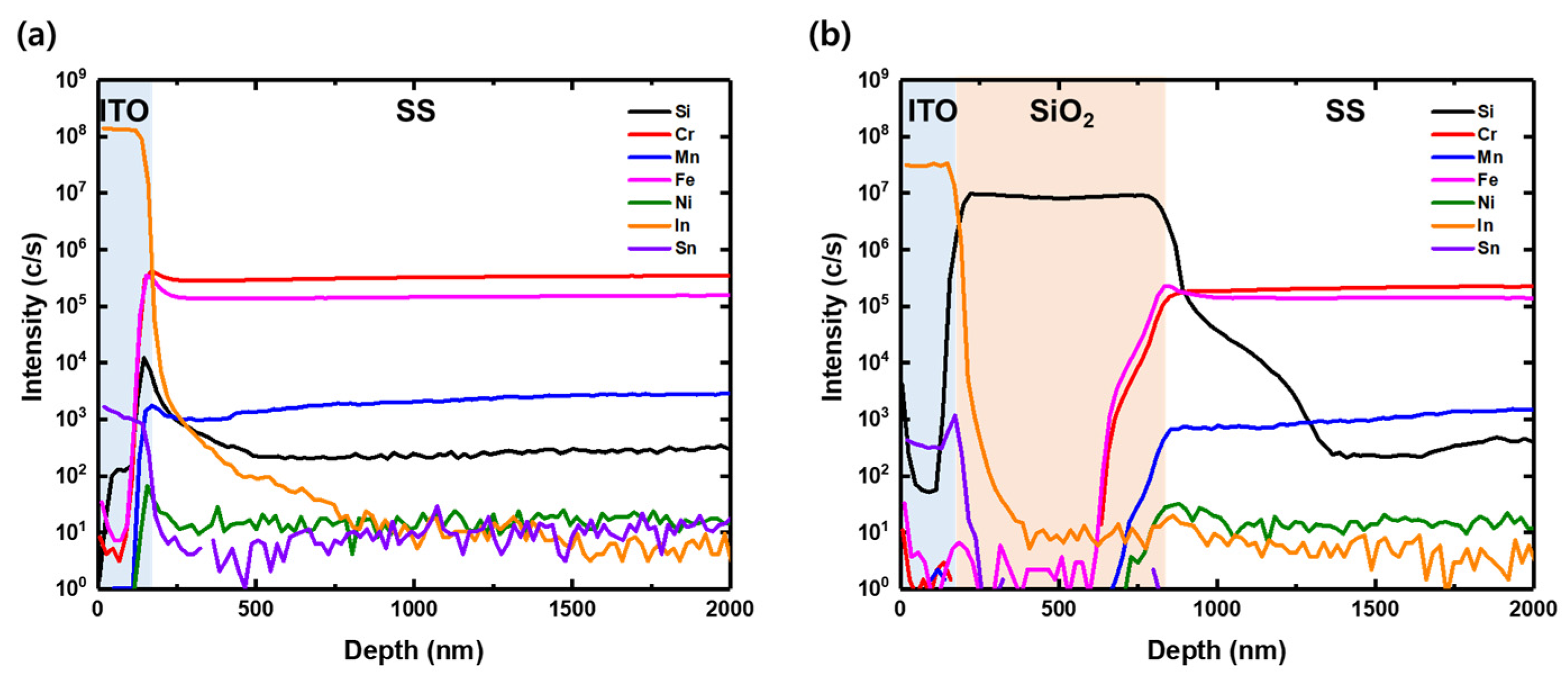
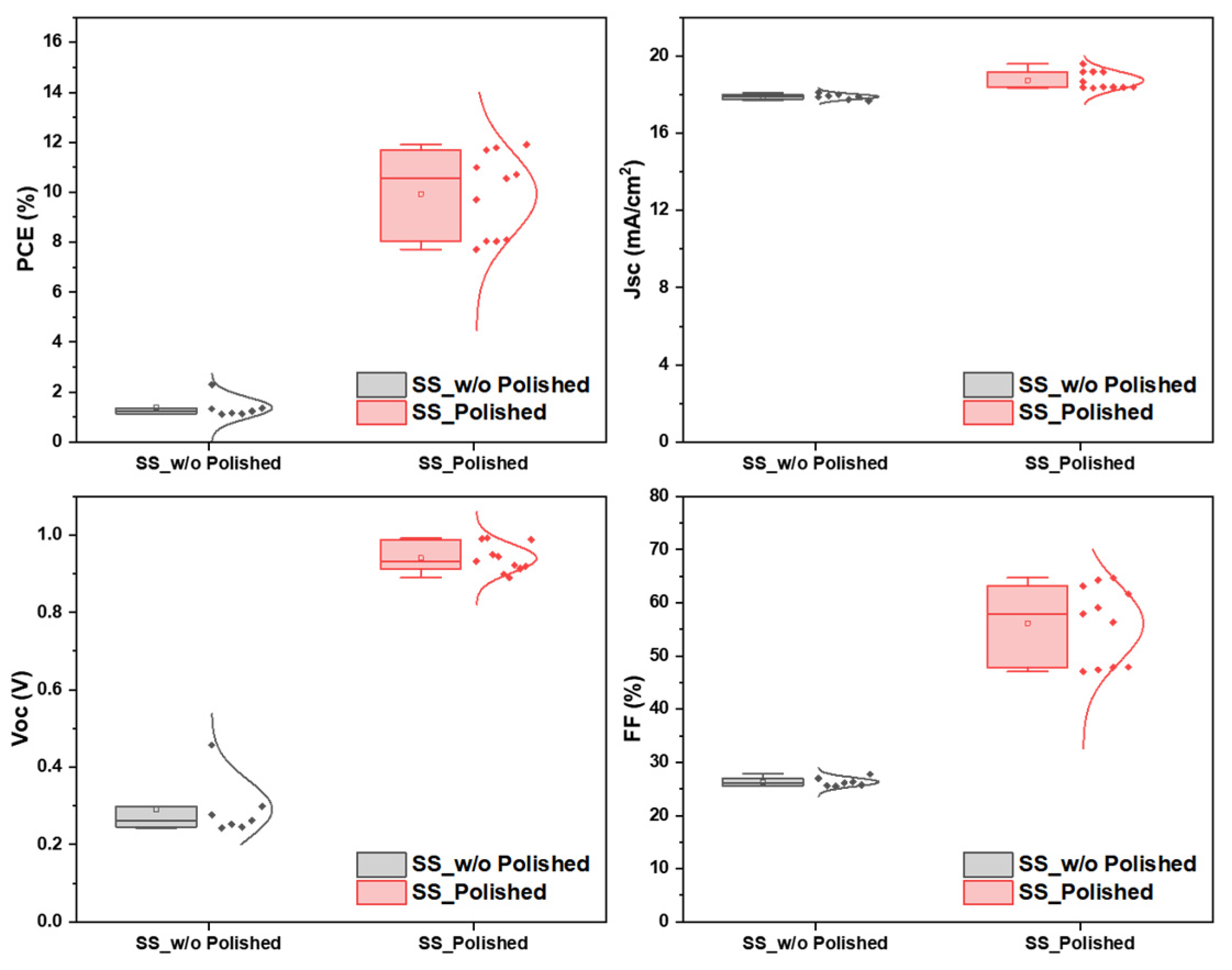
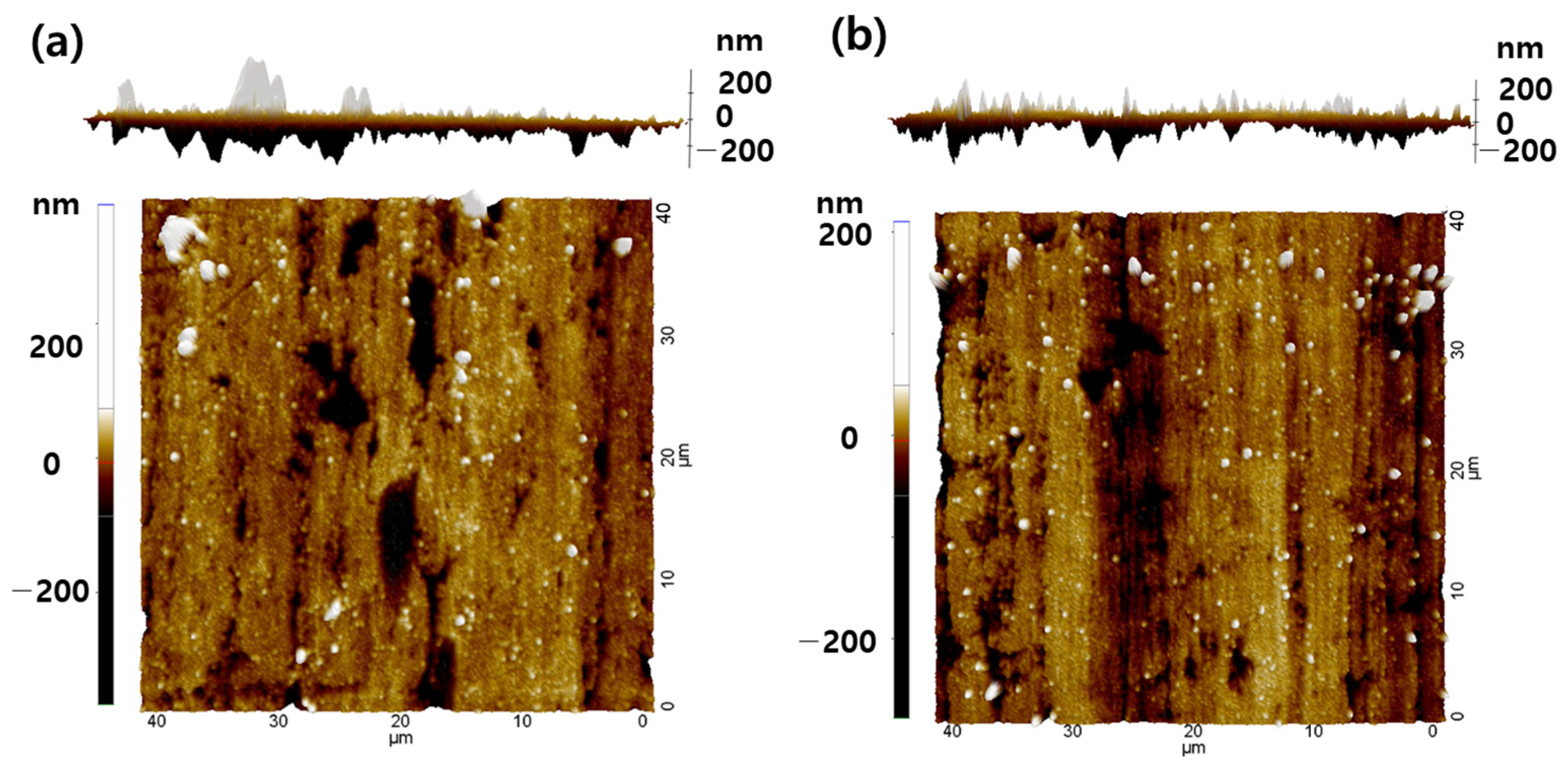

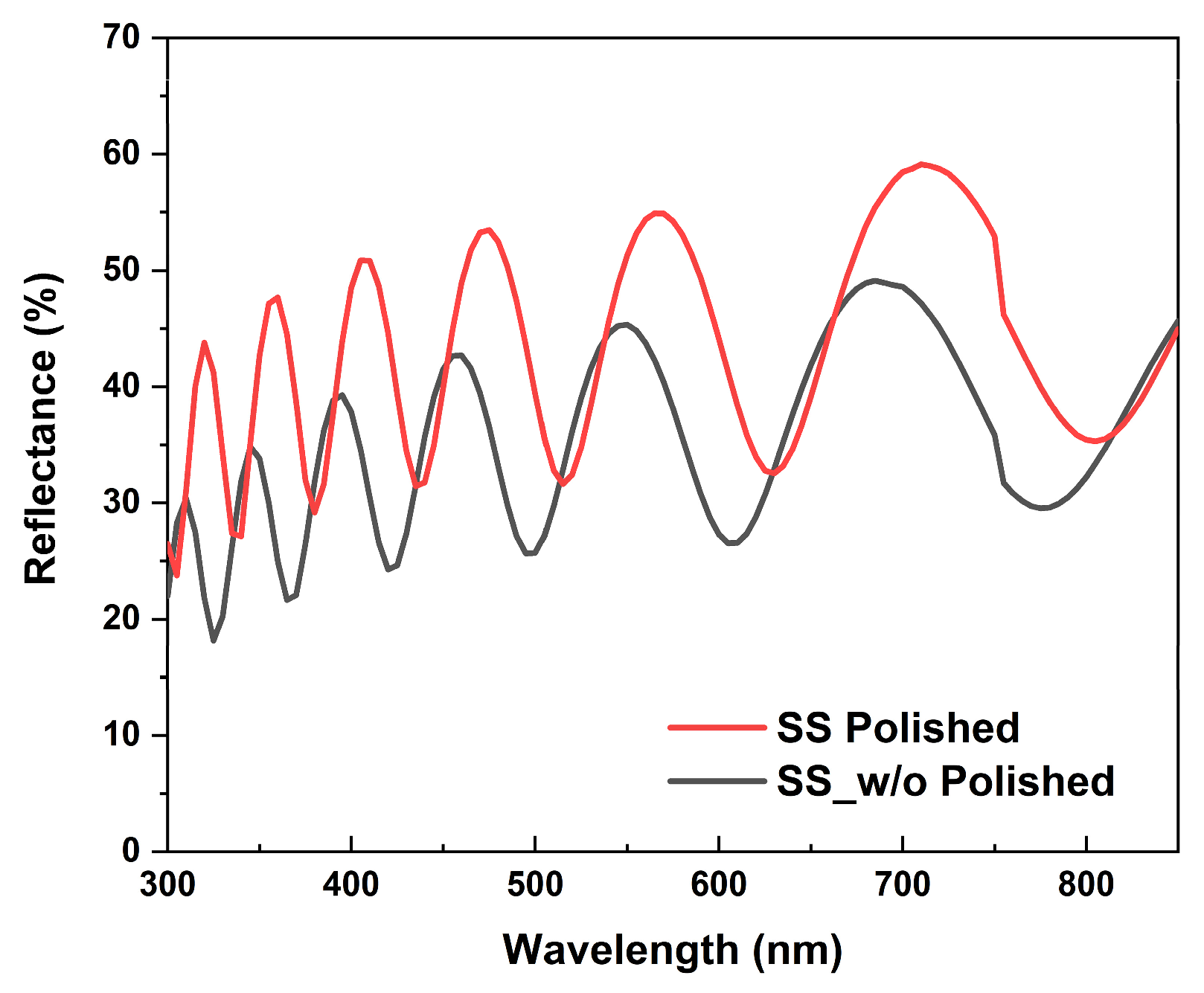
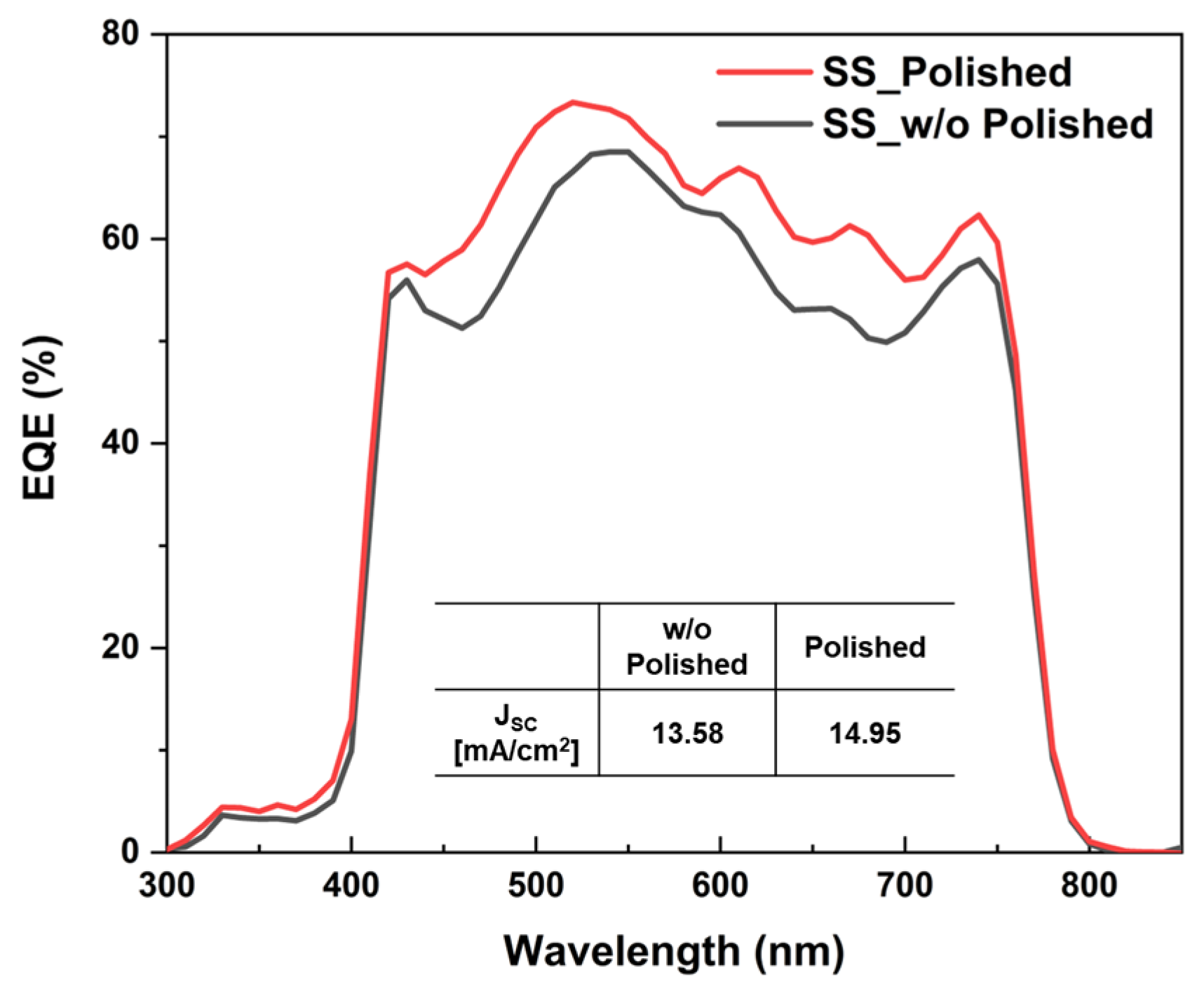

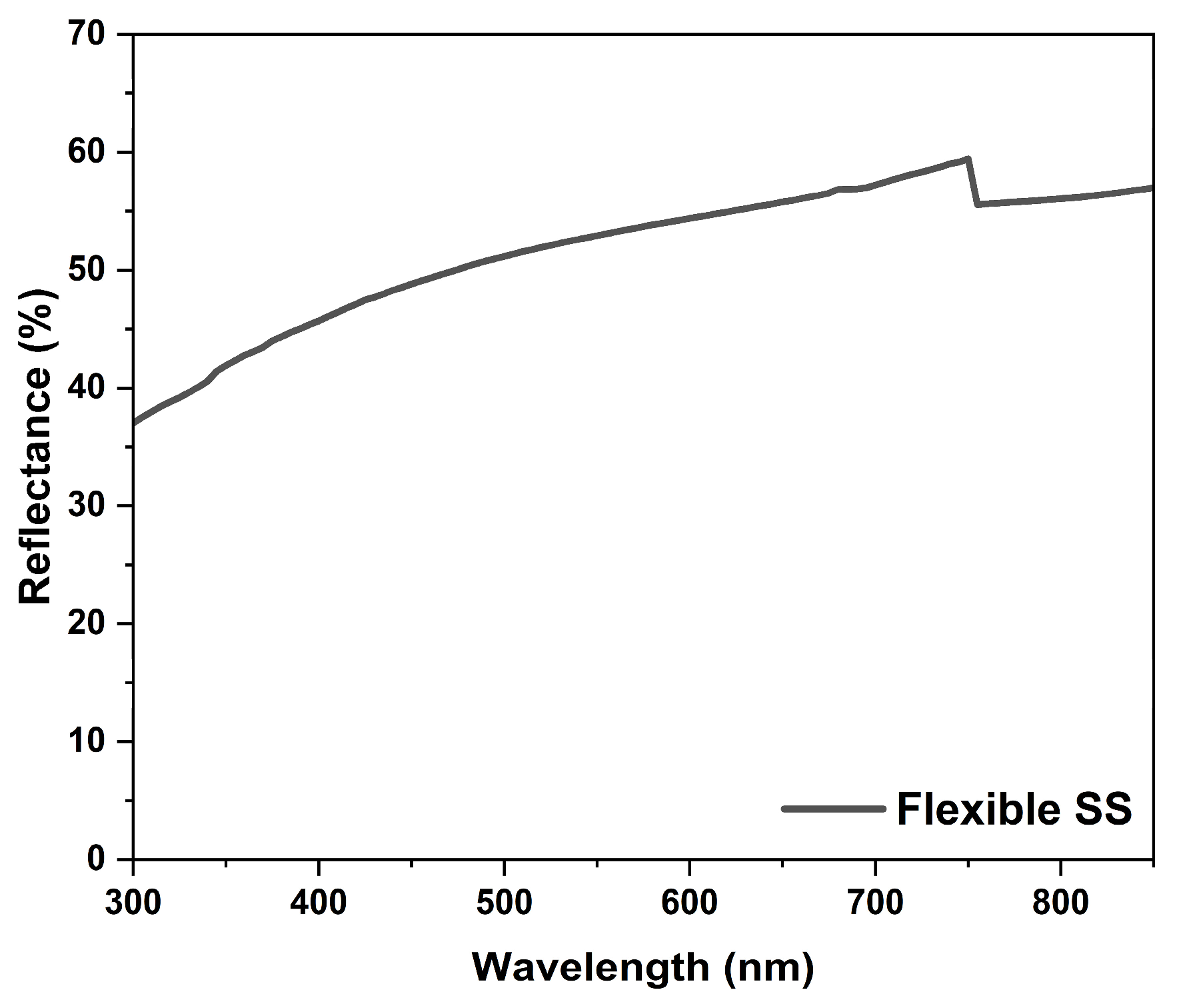
| Unit | w/o Polished SS | Polished SS | |
|---|---|---|---|
| PCE | % | 2.30 | 11.9 |
| JSC | mA/cm2 | 18.1 | 19.6 |
| VOC | mV | 457 | 988 |
| FF | % | 27.8 | 61.7 |
| Unit | w/o Polished SS | Polished SS | |
|---|---|---|---|
| Rp | nm | 962 | 447 |
| RMS | nm | 57.4 | 25.2 |
| Ra | nm | 32.2 | 16.8 |
Disclaimer/Publisher’s Note: The statements, opinions and data contained in all publications are solely those of the individual author(s) and contributor(s) and not of MDPI and/or the editor(s). MDPI and/or the editor(s) disclaim responsibility for any injury to people or property resulting from any ideas, methods, instructions or products referred to in the content. |
© 2023 by the authors. Licensee MDPI, Basel, Switzerland. This article is an open access article distributed under the terms and conditions of the Creative Commons Attribution (CC BY) license (https://creativecommons.org/licenses/by/4.0/).
Share and Cite
Lee, S.; Lee, S.-W.; Bae, S.; Hwang, J.-K.; Lee, W.; Pyun, D.; Jeong, S.-H.; Kim, K.; Hwang, J.-S.; Cho, S.; et al. Perovskite Solar Cell on Stainless Steel Substrate over 10% Efficiency for Building-Integrated Photovoltaics. Energies 2023, 16, 8061. https://doi.org/10.3390/en16248061
Lee S, Lee S-W, Bae S, Hwang J-K, Lee W, Pyun D, Jeong S-H, Kim K, Hwang J-S, Cho S, et al. Perovskite Solar Cell on Stainless Steel Substrate over 10% Efficiency for Building-Integrated Photovoltaics. Energies. 2023; 16(24):8061. https://doi.org/10.3390/en16248061
Chicago/Turabian StyleLee, Solhee, Sang-Won Lee, Soohyun Bae, Jae-Keun Hwang, Wonkyu Lee, Dowon Pyun, Seok-Hyun Jeong, Kyunghwan Kim, Ji-Seong Hwang, Sujin Cho, and et al. 2023. "Perovskite Solar Cell on Stainless Steel Substrate over 10% Efficiency for Building-Integrated Photovoltaics" Energies 16, no. 24: 8061. https://doi.org/10.3390/en16248061
APA StyleLee, S., Lee, S.-W., Bae, S., Hwang, J.-K., Lee, W., Pyun, D., Jeong, S.-H., Kim, K., Hwang, J.-S., Cho, S., Kim, D., Kang, Y., & Lee, H.-S. (2023). Perovskite Solar Cell on Stainless Steel Substrate over 10% Efficiency for Building-Integrated Photovoltaics. Energies, 16(24), 8061. https://doi.org/10.3390/en16248061








